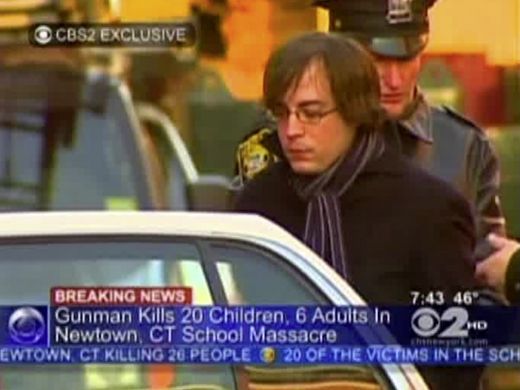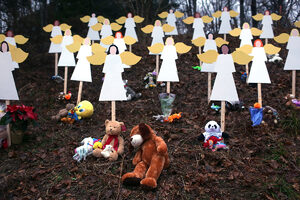“Truth wears no mask, bows at no human shrine, seeks neither place not applause, she only asks a hearing.” ~ Carl A. Wickland
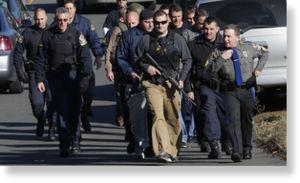 When 20 children and 8 adults were murdered in the Sandy Hook Elementary school massacre we, like most other people, were shocked and horrified at what appeared to be an act of senseless brutality. When a person experiences the tragic and untimely loss of a loved one, particularly in unusual or apparently inexplicable circumstances, the initial intense feelings of grief usually give way to a desire to understand HOW and WHY the tragedy occurred, in an effort to make sense of it and achieve some kind of ‘closure’. This is a very normal and natural human reaction. We have an innate need to understand the world around us and how things ‘work’. In our modern, technological world, most of what we understand about our world and how it works is provided to us by some authority or other. And most of us accept the conclusion of those authorities as being true. In some cases, those explanations are true.
When 20 children and 8 adults were murdered in the Sandy Hook Elementary school massacre we, like most other people, were shocked and horrified at what appeared to be an act of senseless brutality. When a person experiences the tragic and untimely loss of a loved one, particularly in unusual or apparently inexplicable circumstances, the initial intense feelings of grief usually give way to a desire to understand HOW and WHY the tragedy occurred, in an effort to make sense of it and achieve some kind of ‘closure’. This is a very normal and natural human reaction. We have an innate need to understand the world around us and how things ‘work’. In our modern, technological world, most of what we understand about our world and how it works is provided to us by some authority or other. And most of us accept the conclusion of those authorities as being true. In some cases, those explanations are true.
In relation to the Sandy Hook massacre; while the HOW of the attack has been explained, as yet, there seem to be few authoritative answers as to WHY the massacre occurred. That is to say, WHY a lone gunman decided to walk into a school and murder 20 children and 6 adults. At this point, three weeks after the event, it seems that the world will ultimately have to accept the narrative that a lone, disturbed individual murdered those children because he was, well, disturbed. Specifically, it is claimed that Lanza had ‘Asperger’s Syndrome’, yet according to experts, people with this condition do not run a higher risk of killing others or themselves and indeed that they ‘rarely harm others‘. The ‘disturbed individual’ answer is, therefore, a rather unsatisfactory one, but it’s an answer nonetheless.
But here’s a question. What if the explanation provided by authorities about how something happened doesn’t make sense in any truly objective way? More to the point, what if you have reasonable cause to suspect that the official version of events may not be accurate? Logically, you’d think that the same desire to make sense of the tragedy and find closure would remain unsatisfied in such a case. But you’d be wrong to think so, because it seems that most people, particularly those affected most directly by a tragedy, will gratefully accept the first plausible official explanation that is offered to them, even if, as in the case of the Sandy Hook massacre, it doesn’t really explain WHY the tragedy occurred. The reason that most people react in this way is probably due to the same desire to find closure and ‘put it behind them’.
With that in mind, we’d like to state that our previous analyses of the Sandy Hook massacre were in no way motivated by any desire to ‘stir up some shit just for the sake of it’ (as several individuals suggested). Our motivation was, rather, to satisfy our desire to find a more satisfactory explanation of HOW and WHY the massacre occurred, a desire that really resulted from our inability to simply ignore the outstanding inconsistencies in the official story.
But first however, we’d like to draw your attention to some of the more outrageous and false claims being made about the Sandy Hook massacre.
Third Party ‘Actors’ and Conspiracy Nut-jobs
An alarming number of alternative ‘voices’ on Sandy Hook appear to have been taken in by (or are consciously spreading) suggestions that some or all of the child victims’ parents or school teachers are ‘hired actors’ and that the reason there have been no images of corpses in the press is because there were no corpses, suggesting, somewhat hysterically, that the whole event was staged and never actually took place. As far as we are concerned, this is a ridiculous contention with no basis in fact. Under severe emotional stress, ordinary people can and do react in what may seem to be strange ways. It is not uncommon, for example, for people under emotional stress that would normally cause them to break down into a blubbering mess, to burst out laughing. The commonly-used term ‘if you don’t laugh you’ll cry’ indicates a widespread understanding that human emotions are often oxymoronic in nature. Why certain internet media pundits have been unable to arrive at this logical conclusion is a mystery.
As for the lack of pictures of corpses; the reason for that should be self-evident and we find no reason to view it as evidence of any conspiracy.
The below photo of the black Honda civic that belonged to Adam Lanza’s mother has the registration number “872 YEO”:
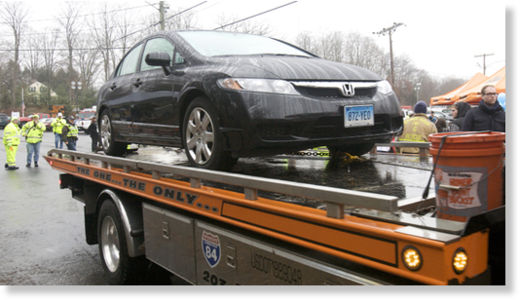
Many internet pundits with impaired common sense have voiced suspicions regarding the vehicle’s ownership because of a segment of the emergency responders’ radio feed from that morning. At 30 minutes, 15 seconds in this supposedly “full-length” version we hear someone, presumably an officer on the scene, read out vehicle registration plates (“872 YEO”). This is followed soon afterwards, at 30 minutes, 50 seconds, by the name “RODIA, CHRISTOPHER A.”, followed by a date of birth of “August 6, ’69” from another officer with a deep voice.
This has been presented as evidence that the car did not belong to Nancy Lanza but someone named Christopher Rodia.
But if you listen to the full audio stream from the original source at RadioReference.com, which includes all police transmissions on that morning from the entire Fairfield county, you realise that the stream includes police radio transmissions from police officers involved in the Sandy Hook shooting AND transmissions from other officers involved in traffic stops etc.
In the *real* full version of the transmissions, you hear a unit “272” giving the 872 YEO license number to a dispatcher, and saying “possible suspect vehicle”. This is a reference to the car Lanza allegedly drove to the school and is obviously from an officer involved in the Sandy Hook shooting response.
About 20 seconds later an officer with a deep voice says “53 Edward, run the operator, he’s a Florida license and Connecticut as well. Last name is Rodia R-O-D-I-A, Christopher… August 6, 1969…” But about 5 minutes before this, this same officer with a deep voice is heard to say “33 headquarters, motor vehicle stop”. The obvious conclusion being that these were two intermingled streams that someone, without an ounce of discernment (like noticing the difference between two voices), decided was evidence that Nancy Lanza’s car belonged to someone else.
Throughout the audio other traffic stops with references to car makes and models can also be heard. There is therefore no reason to believe that the segment about Rodia is anything other than a traffic stop.
As it turns out, there is a Christopher Rodia in Connecticut, one who was arrested in July 2012 in connection with stealing copper piping. More to the point, we have personally seen publicly available tax records which show that Rodia owns a totally different car.
Many people have also speculated on the supposedly bizarre response made by Connecticut state police Lieutenant Vance to a question from a reporter:
http://www.youtube.com/watch?&v=ZRJ_2tFBnt4
To someone with a pre-formed belief that the Sandy Hook shooting involved some kind of conspiracy, the fact that Lt. Vance appears to stall for several seconds and then give an entirely irrelevant answer to the question about Lanza’s mother and her connection to the school, might seem like evidence of a conspiracy. The truth of the matter however, if you listen closely, is that Vance’s ‘stalling’ is due to the fact that he is listening to the question of another reporter. He then answers that question. At press conferences reporters from all angles shout simultaneous questions to the speaker. Lt. Vance is probably fairly well experienced at answering questions from the press and in this video does what most speakers do: point to one reporter and focus on him/her and listen to their question to the exclusion of others. The reason that the voice of the reporter asking the question can be heard above all others is probably because he is standing right beside the camera that is filming. In short, this video is evidence of nothing in particular.
These are just a few examples of the kind of blatant nonsense certain individuals have been spreading about the Sandy Hook massacre. The fact that so much obvious disinformation has been spread about this tragedy, not least by the mainstream media, does not however mean that we should ‘throw the baby out with the bath-water’. In fact, as we shall see, the very fact that the mainstream media got the details of the shooting so completely and repeatedly wrong brings up some interesting questions.
Having looked closely at as much of the details of the shooting as possible, we believe that there is sufficient evidence, (primarily in the form of unanswered questions) to suspect that the full truth about the Sandy Hook massacre may not have been told and that a full public inquiry is therefore warranted. There are those who would say that the ‘security’ forces and agencies that are investigating this matter are under no obligation to reveal any further information to the public, but we beg to differ. The public have been repeatedly encouraged (directly and indirectly) to reflect on the massacre and consider its implications. But any public reflection on this event without the full facts will be a futile exercise. Everyone touched by this brutal event at the very least deserves to be informed of the plain facts of the case.
Adam Lanza in Altercation at SH School on December 13th?
Initial media reports stated that Adam Lanza had been at the school the day before the shooting and was involved in an “altercation” with staff – three of whom were killed the next day.
That claim has since been retracted, with the CT state police stating that they did not know of any reports about any altercations at the school, but there has been no mention of who initially made the claim to the media and on what basis. If the police have this information they have a duty to make it publicly available.
Guns
The official story is that, for some unknown reason, Adam Lanza, a 20 year old ‘nerd’ with Asperger’s Syndrome walked into the Sandy Hook Elementary School and, in a matter of 3-4 minutes, killed 26 staff and students and then killed himself. He did this, we are told, with two handguns and a AR 15 ‘Bushmaster’ semi-automatic ‘assault rifle’. There has however still been no definitive statement about the number and type of weapons that Lanza allegedly brought with him to the school. Police radio communications at the time include reference to a shotgun, for example, and one of the teachers in the school reported that the first shots she heard sounded like shot gun blasts. The official story however does not include any mention of a shotgun in the school.
What police sources have said is that a “mind numbing” quantity of spent cartridges littered the floor of the school. Eyewitnesses reported hearing “hundreds of shots” fired. The shell casings on the school floor were reportedly from a .233 Bushmaster rifle. The mainstream media reported that the Bushmaster rifle had been “found in the trunk of a car” on the morning of the shooting after police arrived at the scene. This was later changed to the rifle being found near Lanza’s body in the school. A separate rifle appears to have been found in the trunk of the same car later in the evening (after dark).
Here is an image of the car allegedly used by Lanza to drive to the school. In this image, it has already been roped off:
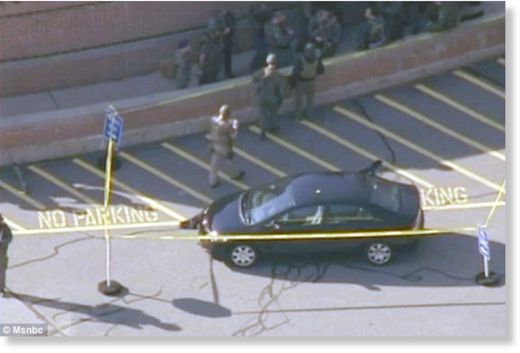
The next video shows what we are told is another rifle being discovered in the trunk of Lanza’s car sometime in the evening of December 14th at the school:
Based on this screen capture from the video, the best match for the gun found in the trunk of the car seems to be a Saiga shotgun with an ATI stock: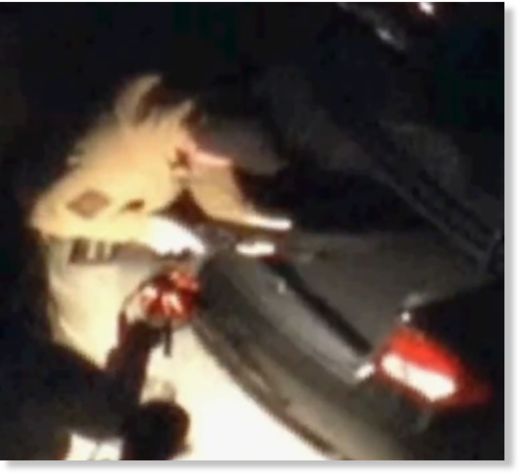
 The problem here is not that there is any clear-cut evidence of conspiracy, but rather that the mainstream media was reporting facts just a few hours after the shooting that would only be officially discovered many hours later by police. Specifically, that a gun was found in the trunk of the Honda Civic Lanza allegedly drove to the school. Our question therefore is: who told the media that a rifle (of any description) was found in the trunk of the car on the morning of the shooting when it seems that the car trunk was only investigated after dark?
The problem here is not that there is any clear-cut evidence of conspiracy, but rather that the mainstream media was reporting facts just a few hours after the shooting that would only be officially discovered many hours later by police. Specifically, that a gun was found in the trunk of the Honda Civic Lanza allegedly drove to the school. Our question therefore is: who told the media that a rifle (of any description) was found in the trunk of the car on the morning of the shooting when it seems that the car trunk was only investigated after dark?
The closest we can get to understanding why the mainstream media was peddling a large amount of inaccurate information about Sandy Hook massacre seems to be the following comment by Paul Farhi of the Washington Post
An Associated Press spokesman, Paul Colford, said the news service got bad information from sources “we had no reason to disbelieve.” He added, “We were confident in our sources, and our sources were wrong.”
But that doesn’t really explain the apparent foreknowledge, so it would be helpful if police authorities investigating the case would attempt to identify these “sources”.
Adam Lanza’s Mother
Many initial media reports stated that Lanza’s mother was a teacher at Sandy Hook School. This claim appears to have been part of a broader story about why Adam Lanza chose to attack Sandy Hook school. The theory was that he was angry at the attention the school children were getting from his mother. These reports were repeated throughout the day by several news agencies until it became clear that Lanza’s mother was not a teacher and had no connection to the school. The WSJ reported
“former school board official in Newtown called into question earlier reports that Nancy Lanza had been connected to Sandy Hook Elementary School, possibly as part of the teaching staff. “No one has heard of her,” said Lillian Bittman, who served on the local school board until 2011. “Teachers don’t know her.”
Despite this, the following video report cites the Sandy Hook school nurse as stating that she knew Nancy Lanza well and that she was indeed a “very experienced” kindergarten teacher.
http://www.youtube.com/watch?&v=-vf2tO5c-L0
Of course, the school nurse could have known Nancy Lanza privately, but again, it would be helpful if police authorities could clear up the question of whether or not Nancy Lanza was a teacher and if she ever had any connection with Sandy Hook school, because, as noted by W. Joseph Campbell, a communications studies professor at American University:
[The idea that Nancy Lanza was killed with her students] “is a narrative that does hang together and explains the story in ways the real story doesn’t. It’s hard for us to accept the idea that something so horrible was completely random. The idea that she had little or no connection to the school makes it harder to wrap your mind around such a horrific and senseless act.”
Lauren Rousseau’s Car
The mainstream media also reported on the fact that several of the cars in front of the school were ‘riddled’ with bullet holes. Here’s an image of the scene sometime in the afternoon of December 14th. You can see the Lanza car at the top of the image surrounded by yellow tape.
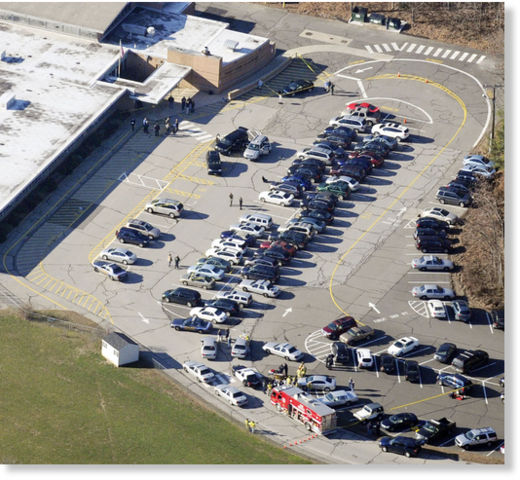
Below is a zoomed-in image of other cars that were also taped off.
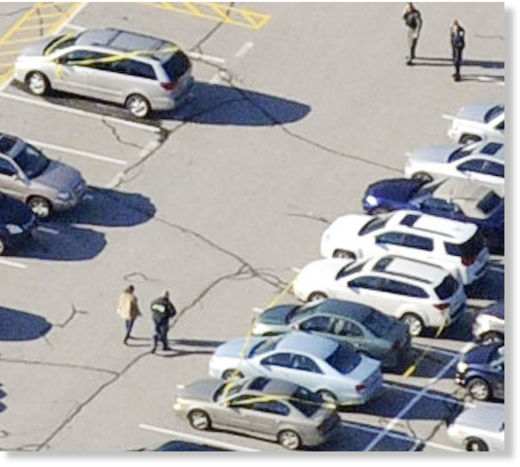
The following video provides evidence that the green Honda owned by Lauren Rousseau was hit by bullets, so it is possible that the other taped-off cars were also hit. Lauren Rousseau, incidentally, was one of the school’s teachers, shot dead along with nearly all her pupils in their classroom.
It would be helpful if authorities could explain how Lauren Rousseau’s car was hit with bullets and if any of the other cars were also hit.
Lanza the Sharp-Shooter
The official story states that Adam Lanza shot his way through the entrance to SH Elementary school where he encountered the principal Dawn Hochsprung and school psychologist Mary Sherlach, both of whom he shot ‘execution style’. Lanza then entered a classroom and shot dead 15 of a total of 16 children (the 16th survived by playing dead as she lay beneath the bodies of her classmates), their teacher Lauren Rousseau and a special-needs teacher, Ann-Marie Murphy. He then left that classroom and entered the classroom of teacher Victoria Leigh Soto and demanded to know where the children where. When Soto said they were in the auditorium, Lanza shot her, another special-needs teacher, Rachel D’Avino, and four of their students, who emerged from the cupboard in which they were hiding. Lanza then left that room and entered the office of school nurse Sarah Cox, who was hiding under her desk, only to leave again a few moments later. He then went to the classroom of music teacher Maryrose Kristopik and pounded on the door, yelling “Let me in”. Based on police audio transmissions (see below), Lanza did all of that in about 3 minutes. On seeing local police arrive, he shot himself in the head. End of story.
It would be helpful therefore if authorities could explain precisely how Lanza was able to achieve all of this in such a short period of time. It would also be helpful to hear their explanation of how someone who, according to official reports, had not engaged in any gun training prior the attack, could have achieved such proficiency and deadly accuracy with an assault rifle.
Second Shooter?
In the immediate aftermath of the massacre, many mainstream media outlets reported that there may have been a second shooter. Several of these reports made it clear that, at the time, this was a distinct possibility.
For example, the Washington Post quoted an AP report that “a law enforcement official in Washington said that the suspect was Ryan Lanza, that his younger brother was being held for questioning as a possible second shooter and that their mother taught at the school.”
ABC News stated authoritatively that “the massacre involved two gunmen”.
[…] The massacre involved two gunmen and prompted the town of Newtown to lock down all its schools and draw SWAT teams to the school, authorities said today.
One shooter is dead and a manhunt is on for a second gunman. Police are searching cars. One shooter was described as a 24-year-old armed man with four weapons and wearing a bullet-proof vest, sources told ABC News.
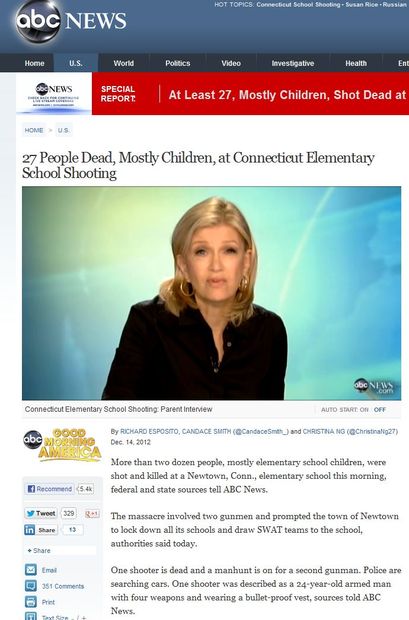
The ABC News report about a manhunt underway for the second gunman
While it is the responsibility of police authorities to tell the public who exactly provided this information about a possible second gunman, it seems reasonable for us to conclude that there was good cause for the police to believe that Lanza was not alone. Indeed, police audio transmissions at the time suggest this to be the case.
Lanza is alleged to have entered the school at about 9.35am. As soon as the first shots were fired, a teacher phoned the police. The first reference on police audio transmissions that day record an officer saying:
“Sandy Hook school, caller is indicating she thinks there is someone shooting in the building”.
2 minutes, 30 seconds later, the same police officer says:
“the shooting appears to have stopped, it is silent at this time, the school is in lock-down.”
45 seconds after that the same police officer says:
“I have reports that the teacher saw two shadows running past the building, past the gym which would be rear….. rear shooting.”
5-10 seconds later, another officer says:
“yeah we got em, they’re coming at me down [inaudible] …. coming up the drive the left side”
1 minute, 45 seconds later, the same officer says:
“[inaudible] I’ve got a party on the [inaudible] I’ve got him proned out.”
5 minutes later an officer makes a reference to “the school” and “the party in custody” and “we’ll continue checking”.
What we can reasonably conclude from these audio transmission is that local police were on the scene very quickly, and that the shooting inside the school lasted little more than 3 minutes. We can also tentatively conclude that there were other ‘persons of interest’ involved and that police may have apprehended one of them.
Looking at an overhead image of the school, we see that the gymnasium is on the right of the building. The reference made by the officer quoting the teacher who saw “two shadows running past the gym” would suggest that two people were running towards the rear of the building past the gym, either before, or just as, police arrived on the scene.
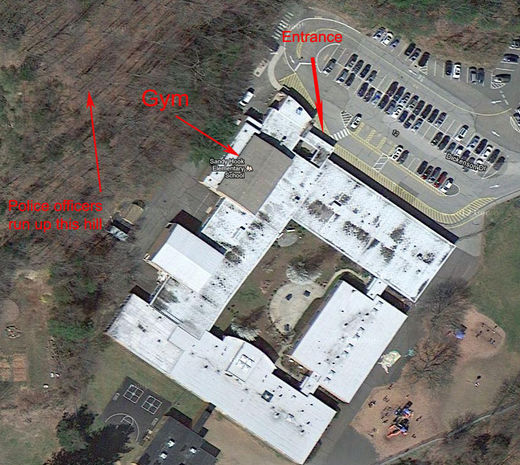
In the following video we see police officers running along the back of building and then up the hill among the trees where, it was initially claimed by media reports, they had apprehended someone, although it is impossible to see much detail through the trees.
In this next video, we see police officers surrounding a house with guns drawn.
The house in question is located just behind Sandy Hook school and directly below the area where the police appear to chase someone into the woods. The house is circled in red in the image below, and the area where the police allegedly arrested someone is circled in yellow.
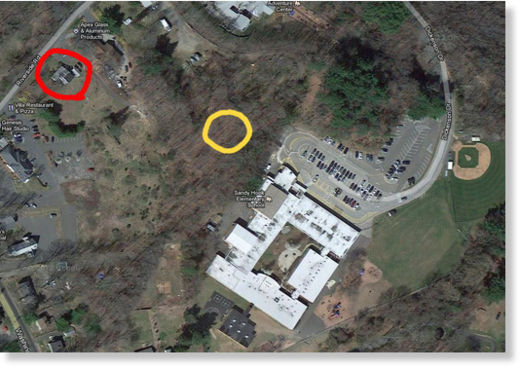
So that you can confirm that this is the house the police officers appear to be investigating in the video above, here is a screen shot of the house from Google Street View. The address is 6, Riverside Road, Newtown, CT.
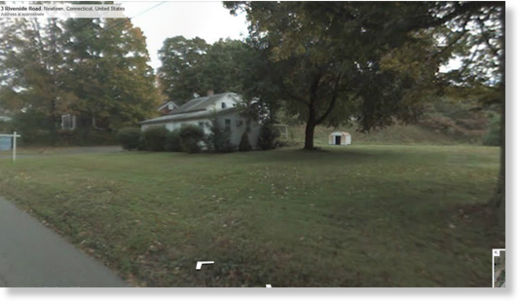
Our questions relating to this information are:
- Did police on the scene have any reason to suspect more than one shooter. If so, why?
- Were the police chasing two other people in connection with the shooting?
- Was one person captured and “proned out” by one officer and did other officers chase another individual into the woods behind the school?
- Were police officers particularly interested in the house at 3, Riverside Road, Newtown, just behind the school and in the direction that the officers appear to have been chasing someone? Or was this just one of several houses/buildings that were checked in this way? If so, what reason was there to engage in such a search, if the details of the crime scene were largely self-evident: that a lone gunman had entered the school and shot 20 children and 6 teachers and then himself within a period of five minutes?
These are legitimate questions that authorities dealing with the investigation have a responsibility to the public to answer.
Precedents – The Sandy Hook Massacre in Context
The Sandy Hook massacre is one of many such mass shootings in the USA over the course of the last 20 years. The most notable of these shootings all have one thing in common: the official story claimed a ‘lone gunman’ was involved, yet eyewitnesses reported at least one other shooter.
Aurora Theater Shooting – July 20th 2012
Eyewitness reports from the Aurora, Colorado theater shooting describe a man seated in the front row of Theater 9 taking a phone call, getting up to open an emergency exit, then waiting for someone else into the theater. The police radio feed from that day indicates that, an hour after arriving on the scene, police were still pursuing at least one other suspect, while an officer can be heard to say, “Sounds like it was a coordinated attack.” The ‘lone gunman’, 24-year-old James Holmes, was arrested by police 1-2 minutes after the first 911 call was made because he was found either inside or next to his car (this has not been clarified), which was parked next to the emergency exit of Theater 9. Holmes was reportedly wearing a gas mask and was equipped with ‘gas cannisters and ballistic gear’; and yet a second gas mask and ‘duffel bag with gas cannisters and ballistic gear’ were found hundreds of feet away from his vehicle.
Sikh Temple Shooting – August 2012
7 people were murdered two weeks after the Aurora theater shooting, on 5th August 2012, when a ‘lone gunman’ opened fire during worship at a Sikh temple in Oak Creek, Wisconsin. Again we would like to know how eyewitness reports of a “very well coordinated” attack conducted by “four white males dressed in all-dark clothing can be reconciled with the official account of a solitary ‘white supremacist’ and “former US Army psychological operations specialist” being shot dead by police who responded to the 911 call.
Fort Hood Shooting – November 5th 2009
A ‘lone gunman’ is said to have shot dead 13 soldiers and wounded 31 more (including support staff) at Fort Hood US Army base in Texas. The perpetrator was identified as US Army Major and psychologist, Nidal Malik Hasan, a Muslim of Palestinian descent. To this day there has been no explanation for the initial reports describing up to three shooters in two separate locations on the world’s largest military base. Listen as US Army Sgt. Major Jamie Posten stresses to the media that he is only willing to divulge that which he knows for sure:
Another senior officer described to CNN the arrest of a second Fort Hood shooting suspect at a golf course 2.5 miles from the base:
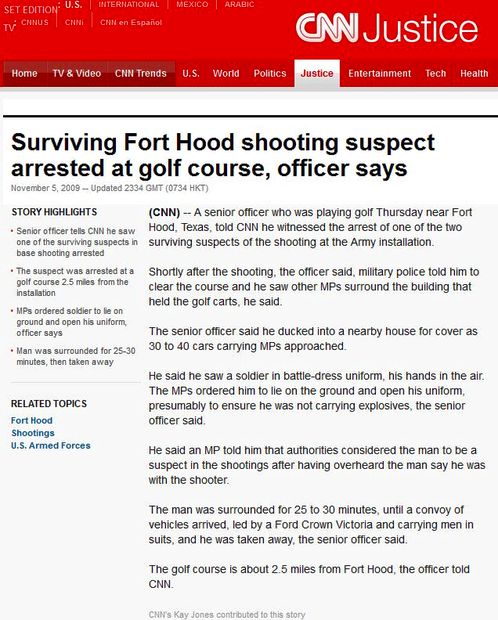
What happened to this suspect?
Virginia Tech Massacre – April 16th 2007
‘Lone gunman’ Seung-Hui Cho is said to have shot dead thirty-three people (five faculty members and 27 students before shooting himself in the head) in a massacre on the campus of Virginia Polytechnic Institute and State University in Blacksburg, Virginia. Cho was a South Korean citizen with U.S. permanent resident status and an undergraduate at the institute. The massacre was the bloodiest school shooting in the country’s history. All of the victims were shot at least three times each; of the 30 killed, 28 were shot in the head. The official record of the event affirms that Cho acted alone, yet, on the day, police reported that they were “hunting for a possible second shooter”.
The testimonies of US military personnel, police officers and people who actually witnessed these shootings describing second (or more) gunmen or suspects being involved cannot simply be dismissed without being acknowledged and taken fully into account.
Ask yourself, what possible reason would there be for eyewitnesses or police officers to report more than one shooter if there was absolutely no evidence of more than one shooter?
Three quarters of Americans believe there was more than one gunman involved in the assassination of John Fitzgerald Kennedy. This means that they do not believe the lone gunman narrative and implicitly acknowledge that a conspiracy took place, a conspiracy that, by definition, involves forces and a power that extends above and beyond the office of the US president, supposedly the highest in the nation (and some would say the world.)
If we reflect on it for a moment, we see that the end result of mass shootings like Sandy Hook serve to instill a generalized sense of fear in the American population and a concomitant tendency to look to authority for protection. Consider this video that the Alabama Dept. of Homeland Security produced in direct response to the Sandy Hook massacre. The director of the Alabama Dept. of Homeland Security wants to encourage people to “run, hide, fight”. The video begins with the words:
“It may feel like just another day at the office, but occasionally, life feels more like an action movie than reality. The authorities are working hard to protect you and protect our public spaces. But sometimes bad people do bad things. Their motivations are different, the warning signs may vary, but the devastating effects are the same. And unfortunately you need to be prepared for the worst…”
Gun Control?
The Sandy Hook school massacre was not a covert attempt to take away Americans’ ‘right to bear arms’ as defined in the 2nd amendment of the US constitution. Every time that a shooting of this nature takes place, the sale of guns across the USA increases dramatically. There is no evidence that the US government is planning to use the Sandy Hook massacre to justify an attempt to ban the private ownership of guns in the USA. In any case, it would be almost impossible to enforce any such laws. The USA does indeed have a gun crime problem compared to other nations, but the problem obviously isn’t the guns themselves but the people who use them.So why are there so many people in the USA that use their guns against other Americans?
The answer most likely lies in the nature of American culture and society. There is a vast underclass in the USA that has, for many decades, been economically marginalised and abandoned by an increasingly ‘broken’ eduction system that turfs many of them out on to the street at 16 years of age, barely able to read or write and with job prospects somewhere between minimum wage and unemployed. At the same time, these people are encouraged by a relentless media and corporate campaigns to ‘consume’ and have the best of everything the American capitalist dream can offer. It’s not hard to see how many of these disenfranchised might turn to crime (which in the US often means gun crime because of the easy access and ‘right’ to guns) in an effort to secure their piece of the pie.
The knock-on effect of gun crime (and the media reporting of such crimes) for members of the more privileged middle class (particularly those in large cities) is a palpable sense of insecurity. Exacerbating this feeling is the obnoxious amount of violence displayed on American TV and Hollywood-produced movies. By age 18, the average American child will have seen 16,000 murders and 200,000 acts of violence on TV or in movies, and most of this violence is depicted as taking place on American streets. Such programming simply re-enforces the perception that the streets of the USA are not safe because the human subconscious does not really distinguish between real and simulated violence.
This feeling of a pervasive yet vague and unnamed threat probably plays a significant role when it comes to average American citizens deciding whether or not to buy a gun. More importantly, people who sense that the society in which they live is not safe will be much more likely to accept the increasing militarization of their society and the forces of law and order and, ultimately, the destruction of their civil liberties because it is all being done ‘for their own protection’.
Indiscriminate and ‘inexplicable’ massacres like Sandy Hook (and dozens of others) are the ‘icing on the cake’ in this process; it is up to each to decide whether or not they may be by design.

